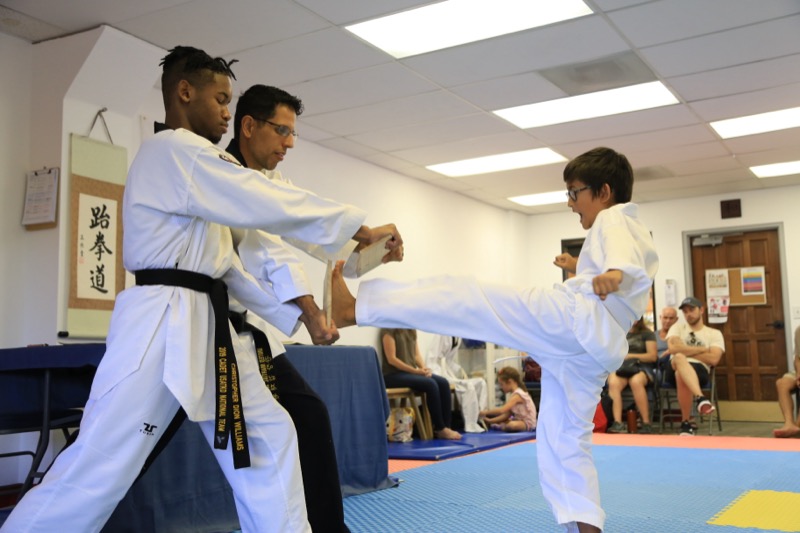
When your child begins their martial arts journey, every step is filled with opportunities for growth, discipline, and triumph. Among these milestones, the first board break stands out as a defining moment, symbolizing more than just physical strength—it’s a testament to mental focus and overcoming self-doubt. As a parent, understanding how to support and prepare your child for this thrilling experience can transform it into an empowering memory. Here’s a guide to what board breaking involves, its benefits, and how to help your child succeed in this key martial arts achievement.
The Significance of Board Breaking
Board breaking in martial arts is a tradition steeped in both physical and philosophical purpose. Beyond the dramatic snap of wood lies an important lesson about precision, power, and perseverance.
Why Martial Artists Break Boards
- Testing Technique
Board breaking requires flawless execution. The ability to break a board cleanly demonstrates mastery of form, alignment, and power transfer. It’s a tangible way for students to measure their technical progress. - Boosting Confidence
Few moments match the satisfaction of successfully breaking a board. This milestone builds self-belief, showing young martial artists they’re capable of achieving difficult goals through effort and determination. - Fostering Mental Focus
To break a board, focus is key. Students learn to channel their attention and energy into a precise strike—a skill that translates into improved focus in other areas of life, including academics and personal challenges. - Overcoming Fear
Board breaking encourages students to confront fears, whether it’s fear of failure, pain, or the unknown. Successfully breaking a board becomes a metaphor for tackling challenges head-on and emerging victorious.
Physical Preparation
Perfecting the Technique
Technique is the cornerstone of successful board breaking. A strike that’s powerful yet misaligned will fail, while a precise strike—even with moderate strength—can achieve the goal.
- Listen to Instructors
Encourage your child to pay close attention during class. Instructors will break down the mechanics of the strike, from stance to follow-through. - Drills and Practice
Repetition builds muscle memory. Practicing kicks, punches, or strikes in slow motion helps refine form, ensuring every movement is deliberate and controlled. - Alignment and Precision
Explain to your child that the goal isn’t brute force but accuracy. Proper alignment of the hand, foot, or elbow ensures maximum impact with minimal effort.
Building Strength and Endurance
Strengthening key muscle groups aids in generating power and maintaining control.
- Targeted Exercises
Push-ups strengthen the arms for hand strikes, while squats and lunges improve leg power for kicks. Core exercises like planks help with overall stability. - Flexibility Training
Include stretches that enhance flexibility, especially in the hips, legs, and shoulders, to facilitate a full range of motion. - Balance Work
Activities like one-legged stances or using a balance board improve stability, crucial for maintaining precision during a strike.
Mental Preparation
Board breaking challenges not only the body but also the mind. Building confidence and focus is vital to success.
Visualization Techniques
Teach your child to picture themselves successfully breaking the board. Encourage them to imagine every detail, from the stance to the follow-through and the sound of the wood snapping. Visualization creates a mental blueprint for success.
Controlled Breathing
Deep, steady breathing calms nerves and focuses energy. Practicing breathing exercises before the attempt can help your child approach the board with clarity and confidence.
Building Resilience
Remind your child that it’s okay if they don’t succeed on the first try. Every attempt teaches something valuable, whether about form, focus, or perseverance. Use any setbacks as opportunities for growth.
Emotional and Psychological Growth
Overcoming Fear
Fear of failure or the unknown can hold children back. Help your child confront these fears by normalizing them and framing the experience as a learning opportunity.
- Talk It Through
Discuss what breaking the board will feel like and emphasize the instructor’s support throughout the process. - Celebrate Effort
Remind your child that attempting the break is an achievement in itself. Whether they succeed immediately or need another try, their determination is worth celebrating.
Teaching Life Lessons
Board breaking is more than a martial arts milestone—it’s a life lesson about determination, discipline, and the rewards of effort. Use this experience to reinforce the idea that challenges are opportunities to grow.
Tips for Parents: How to Support Your Child
- Be Encouraging
Offer words of encouragement and remind your child of their progress. Share their excitement and assure them that you’re proud of their effort, no matter the outcome. - Create a Positive Environment
Avoid adding pressure by setting expectations. Instead, focus on the joy of learning and the pride that comes with trying something new. - Practice Together
If possible, practice alongside your child at home. Mimicking their drills or joining their warm-ups can make preparation feel less daunting and more fun. - Celebrate Success
Whether they break the board on their first attempt or after several tries, celebrate their courage and hard work. Acknowledge the lessons they’ve learned throughout the process.
The Power of Breaking Barriers
When a young martial artist breaks their first board, it’s more than a demonstration of physical strength. It’s a breakthrough—a moment that encapsulates their discipline, focus, and determination. For parents, witnessing this triumph is an opportunity to celebrate not just the accomplishment, but the values and lessons that make it possible.
With the right preparation and encouragement, this milestone becomes a transformative experience, empowering your child to face challenges with confidence both inside and outside the dojo.
Written by AI & Reviewed by Clinical Psychologist and Head Coach: Yoendry Torres, Psy.D.
Disclaimer: Some blog posts may contain affiliate links, and TKD Wellness will earn a commission if you purchase through those links at no additional cost to you. We recommend products and services that we trust and have found helpful. Thank you for supporting our website!